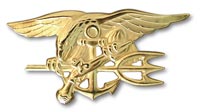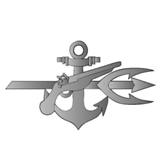
The U.S. Navy’s SEA, AIR, LAND (SEAL) forces are the elite Special Operations forces of the US Navy. The SEAL teams are one of the most respected commando forces in the world – they are often cited as the most elite, flexible and highly trained Naval Commando force. When it comes to Maritime Special Operations and Anti / Counter-Terror operations the SEALs are hard to beat.
Formed in 1962 by President J. F. Kennedy as a maritime counterpart to the U.S. Army Special Forces (the “Green Berets”), the SEALs have amassed a remarkable history of successes and have become legendary in their exploits. The Teams have operated in every hellhole known to modern warfare and come away with many victories, some bruises and a vast history of achievements. Most SEAL missions are unreported and unknown to the general public. Due to focus, dedication, training, and an attitude that “Failure is NOT an option” the Teams have have been very successful.
SEALs are trained to operate in small units of one or two men up to platoon strength of sixteen. However, they work best in squads of eight or fewer. Most missions are clandestine in nature, planned in exacting detail and executed with precision and swiftness. During peacetime, SEALs find themselves with the same rigorous training as during war. Training remains strict to enforce the belief that the more you sweat in peacetime, the less you will bleed in war.
During Vietnam, SEAL Teams One and Two amassed a combined kill ratio of 200:1, with only 46 deaths resulting mostly from accidents and poor intelligence, rather than enemy direct fire. See the History section for an in-depth look at this conflict. Many Vietnam era SEAL vets have written some great books about this episode in SEAL history, which are covered in the Navy Seals Books section.
The SEALs performed heroically in Operation Urgent Fury in Grenada; Just Cause in Panama; Desert Shield/Storm in Iraq (200 combat missions without casualty); Restore Hope in Somalia and most recently in Operation Enduring Freedom in Afghanistan and Iraqi Freedom. Look for these operations and more in the Operations section. Further, the SEALs are operating on all continents and in/on or under all conditions right now?s you read these words.
Whenever the Commander in Chief needs a no-nonsense, decisive and lethal solution to a foreign policy problem, including counter-terrorism strike forces, the U.S. Navy SEALs are the force of choice.
SEAL Teams
Naval Special Warfare has eight Navy SEAL Teams. Each is led by a Navy SEAL Commander (O-5) and is composed of a HQS element and eight operational 16-man SEAL Platoons. These platoons rotate in a continuous, rigorous planned cycle of training and overseas deployments to their Team’s primary overseas Operational Area of Responsibility. However, in time of war such as Iraq and Afghanistan, all the Navy SEAL Teams will participate. Platoons can be structured to operate as eight-man Squads, four-man Fire Teams, or two-man Sniper/Reconnaissance Teams, as required. This makes the SEAL forces light, mobile, swift, effective and virtually undetectable. SEALs can expect to do tours of duty at both East and West Coast SEAL Teams, at SDV Teams, and Naval Special Warfare Units abroad during their careers.
Naval Special Warfare Group ONE
|
Naval Special Warfare Group TWO
|
|---|---|
|
|
Number of SEAL Forces NSW is a remarkably small, elite force. There are 2,450 active duty SEALs, (just 1% of all Navy personnel), and 600 active duty SWCC. These forces spearhead our global maritime security worldwide. NSW reserves number 325 SEALs, 125 SWCC, and 775 support personnel. Navy SEALs have proven so potent a “force multiplier” in the war against terror in Afghanistan and in Iraq, that the Pentagon has ordered a 25% increase in SEAL forces over four years (by 2011).
Last year, only 86% of the Enlisted SEAL jobs allocated to the force were filled. The Navy is offering all new Enlisted SEALs a generous Enlistment Bonus of $40,000 for completing BUD/S training and obligating for 4-years service. Enlisted personnel also currently receive Selective Reenlistment Bonuses (SRB) of up to $75,000.
For SEAL Enlisted and Warrant Officers with 19 – 25 years of service, a Critical Skills Retention Bonus (CSRB) of up to $150,000 is available.
The nation’s demand for NSW Officers has grown by 69% over the past 5 years. As of May 1, 2007, a Critical Skills Retention Bonus (CSRB) is being offered for the first time as an incentive to retain mid-grade officers, O4 – O6, who are undermanned within NSW. Officers who select a 3-year extension will receive a bonus of $15,000 per year ($45,000 total), while a 5-year contract offers $25,000 per year ($125,000 total).
NSW Officers can also qualify for a Special Warfare Continuation Bonus (SWCB) of up to $15,000 per year for serving an extra 5 years ($75,000 total).
SEAL Enlisted, Chief Warrant Officers, and Officers
The majority of Navy SEALs (about 2,000) are Navy Enlisted personnel (E-4 to E-9). They are led by roughly 500 SEAL Officers (O-1 to O-10). There is also a small number of SEAL Warrant Officers (circa 30) who rank as officers above the senior-most Enlisted but lower than an Officer (O-1). While Navy SEALs are usually generalists, Warrant Officers are highly-skilled, single-track specialty officers who are technical experts their entire careers. SEAL Warrant Officers provide valuable skills, guidance, and expertise to commanders and organizations in their particular field. The SEAL force is currently experiencing unprecedented growth in size and Flag positions due to its critical role in the Global War on Terrorism.
The Commander of all Navy SEAL forces (Commander, Naval Special Warfare Command) is a two-star Admiral (O-8). The highest-ranking SEAL in the U.S. Navy is a four-star Admiral (O-10) Eric T. Olson who recently assumed duties as Commander of U.S. Special Operations Command (USSOCOM). Admiral Olson is the first SEAL to achieve four-star rank as well as the first SEAL to command USSOCOM.
Special Warfare Operator (SO) Rating
In May 2006 the U.S. Navy authorized the establishment of the Special Warfare Operator (SO) general rating to allow Enlisted Sailors to focus on rating-specific technology, skill sets, and training systems demanded for the Global War on Terrorism. The rating is also intended to broaden the professional development, career opportunities, and quality of service for these Sailors. This new rating was implemented in October 2006.
SEAL Warfare Designator
As of October 1, 2006, the Enlisted SEAL Warfare Designation (NSW Rating) became “Special Warfare Operator” (SO), representing its own specialized Navy career path. Concurrently, the Enlisted SWCC (NSW Rating) became “Special Boat operator,” also with its own specialized Navy career path. SEALs and SWCC no longer use and wear regular Navy ratings – such as boatswain’s mate, gunner’s mate, hospital corpsman or operations specialist – that they earned before entering the Naval Special Warfare community.
SEAL Warfare Insignia
 The SEAL Warfare Insignia is approved for wear by those who have qualified to be Navy SEALs by successfully completing BUD/S and SEAL Qualification Training. The Special Warfare pin is worn on Navy dress uniforms. It is also known officially as the SEAL Trident, and informally as the “Budweiser” because of its resemblance to the Annheuser-Bush eagle logo.
The SEAL Warfare Insignia is approved for wear by those who have qualified to be Navy SEALs by successfully completing BUD/S and SEAL Qualification Training. The Special Warfare pin is worn on Navy dress uniforms. It is also known officially as the SEAL Trident, and informally as the “Budweiser” because of its resemblance to the Annheuser-Bush eagle logo.
Special Warfare Operator (SO) Rating Badge
 The Special Warfare Operator Badge is an all-black, cloth version of the SEAL Warfare Insignia that is worn by Enlisted SEAL personnel on camouflage utilities (except during operations). It consists of an Anchor crossed horizontally by a Trident and diagonally by a Flintlock Pistol.
The Special Warfare Operator Badge is an all-black, cloth version of the SEAL Warfare Insignia that is worn by Enlisted SEAL personnel on camouflage utilities (except during operations). It consists of an Anchor crossed horizontally by a Trident and diagonally by a Flintlock Pistol.

